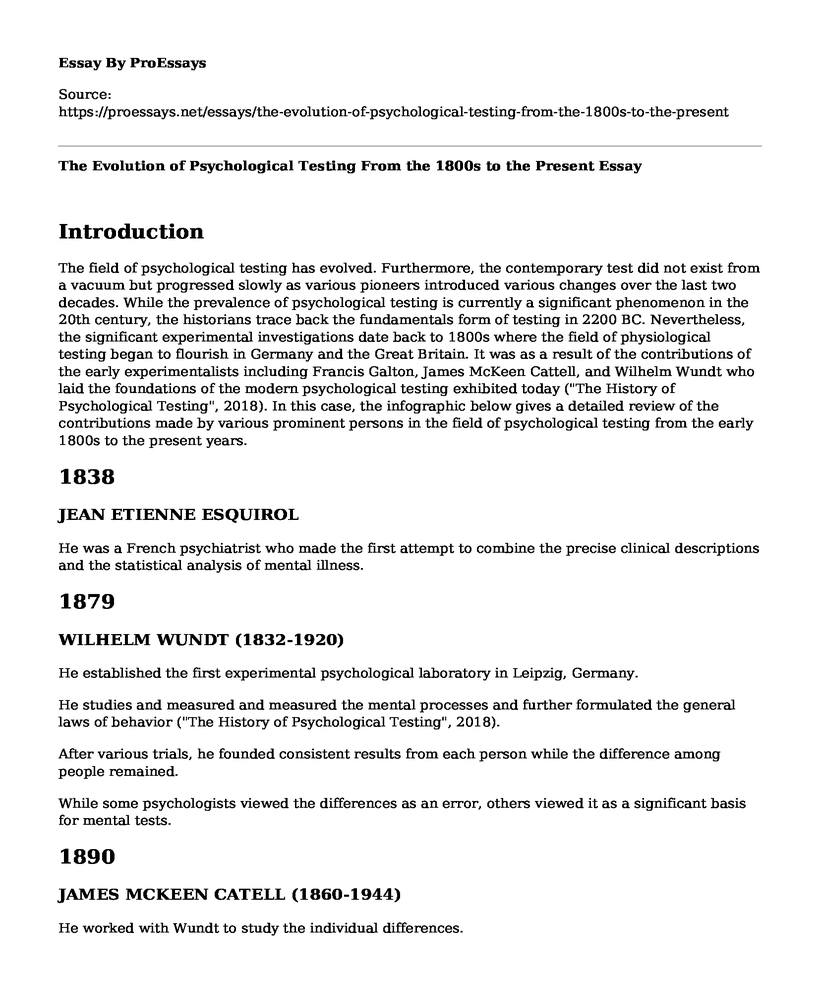Introduction
The field of psychological testing has evolved. Furthermore, the contemporary test did not exist from a vacuum but progressed slowly as various pioneers introduced various changes over the last two decades. While the prevalence of psychological testing is currently a significant phenomenon in the 20th century, the historians trace back the fundamentals form of testing in 2200 BC. Nevertheless, the significant experimental investigations date back to 1800s where the field of physiological testing began to flourish in Germany and the Great Britain. It was as a result of the contributions of the early experimentalists including Francis Galton, James McKeen Cattell, and Wilhelm Wundt who laid the foundations of the modern psychological testing exhibited today ("The History of Psychological Testing", 2018). In this case, the infographic below gives a detailed review of the contributions made by various prominent persons in the field of psychological testing from the early 1800s to the present years.
1838
JEAN ETIENNE ESQUIROL
He was a French psychiatrist who made the first attempt to combine the precise clinical descriptions and the statistical analysis of mental illness.
1879
WILHELM WUNDT (1832-1920)
He established the first experimental psychological laboratory in Leipzig, Germany.
He studies and measured and measured the mental processes and further formulated the general laws of behavior ("The History of Psychological Testing", 2018).
After various trials, he founded consistent results from each person while the difference among people remained.
While some psychologists viewed the differences as an error, others viewed it as a significant basis for mental tests.
1890
JAMES MCKEEN CATELL (1860-1944)
He worked with Wundt to study the individual differences.
He adopted the sensory tests from Galton
He invented the mental tests also known as mental testing
He prepared the United States to accept and embrace psychological tests.
1883
SIR FRANCIS GALTON (1822-1911)
He was the first psychological to identify the significance of differences among people.
He identified that intelligence was inheritable
He developed the first mental ability tests, the first questionnaire, and the first test to measure the relationship between variables and ideas.
He developed various statistical techniques that helped him analyze his data. The procedures include some used today.
1905
ALFRED BINET
He worked with the help of Theodore Simon to create the first intelligence tests.
They developed the Binet - Simon scale in 1905 which was later revised in 1908 ("The History of Psychological Testing", 2018).
The study focused on mentally disabled children as compared to normal children.
Binet worked under the assumptions that in a normal child, the intelligence grows with age and the verbal ability measured the best index of intelligence.
1916
LEWIS TERMAN (STANFORD)
He created the revised Binet- Stanford scale based on 1000 American students aged between 3 to 13 years (Karier & Minton, 1990).
DAVID WECHSLER
He created the intelligence tests for adults
He also revised the intelligence tests for children
1920-1940
PROJECTIVE PERSONALITY TESTING
There was the introduction of aspects such as factor analysis and projective tests for personality testing.
In 1921, Herman Rorschach developed the Rorschach Inkblot Test.
In 1935, Henry Murray developed the Thematic Apperception Test (TAT)
1942-1992
OBJECTIVE PERSONALITY TESTING
In 1943, the University of Minnesota developed the Minnesota Multiphasic Personality inventory (Goldfinger, 2018).
In 1992, they developed a version for the adolescents, and the test results were administered through empirical research.
1n 1946, there was the development of the 16PF which stands for the Cattell's Sixteen Personality Factor Questionnaire.
1995- PRESENT
Some of the techniques such as the 16PF have been integrated into psychological testing to date.
Nonetheless, most of the methods are more automated today (Goldfinger, 2018).
References
Goldfinger, K. (2018). Psychological testing in everyday life: History, science, and practice. Los Angeles : SAGE
Karier, C., & Minton, H. (1990). Lewis M. Terman: Pioneer in Psychological Testing. The Journal Of American History, 76(4), 1294. doi: 10.2307/2936670
The History of Psychological Testing. (2018). Retrieved from http://www.ablongman.com/partners_in_psych/PDFs/Gregory/gregory_ch01.pdf
Cite this page
The Evolution of Psychological Testing From the 1800s to the Present. (2022, Jul 20). Retrieved from https://proessays.net/essays/the-evolution-of-psychological-testing-from-the-1800s-to-the-present
If you are the original author of this essay and no longer wish to have it published on the ProEssays website, please click below to request its removal:
- Improving Rumination and Decreasing Symptoms of Depression - Essay Sample
- The Influence of Parental Style on Adolescent Behavior Essay Example
- Essay on Michigan Mental Health Care: Inpatient Facility and Resource Challenge
- Essay Example on Sidney Poitier: Achieving Perfection Through Practice
- Mental Health Challenges in the COVID-19 Pandemic: 45% of US Adults Affected - Essay Sample
- Free Essay Example: Young People Need Fulfillment of Basic Needs in Classroom
- Paper Exploring Recidivism Risk Assessment and Interventions: Key Insights from Recent Research







